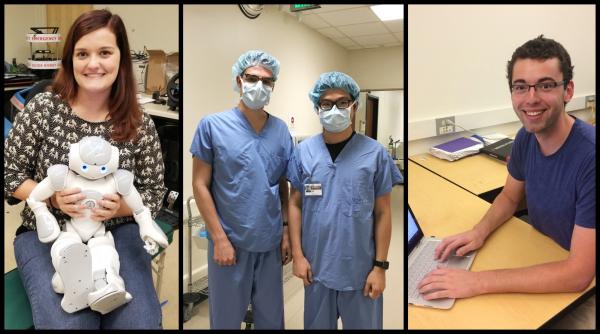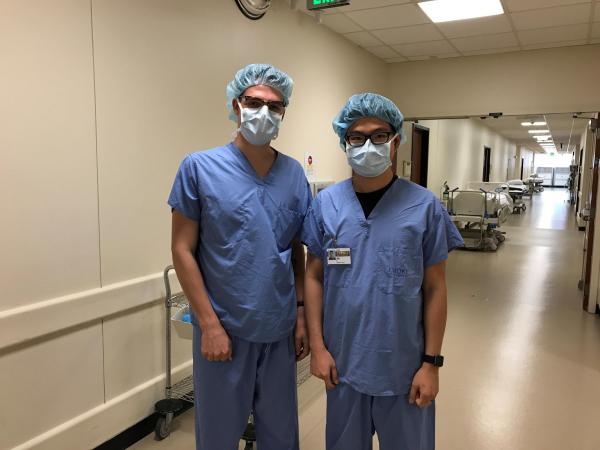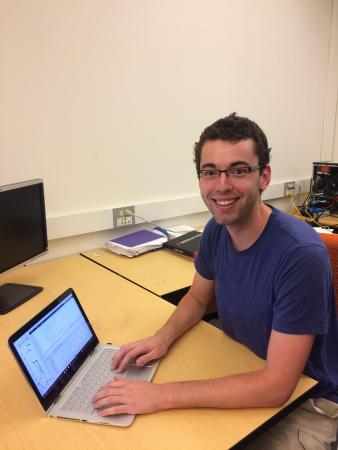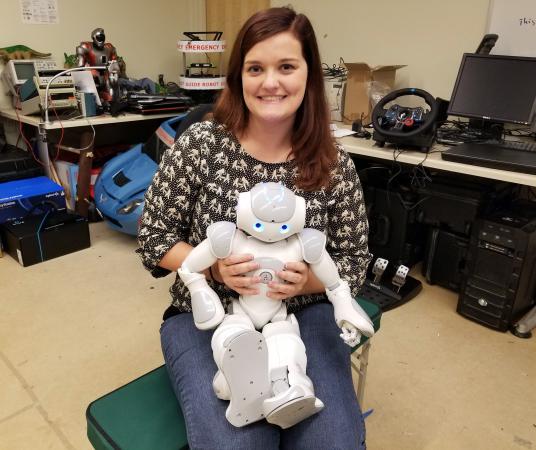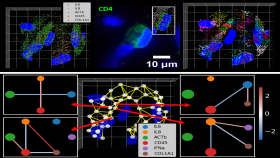Katelyn Fry and Luke Drnach knew two things when they came to the Georgia Institute of Technology for the Ph.D. Robotics Program: they would be attending an institute with one of the best robotics programs in the country, and they would have their pick of world-renowned robotics faculty to guide them. What they did not expect was that they would become best friends through a unique academic program. Not many people can say they bonded over kicking baby dolls and motion capture suits, but these unusual catalysts are what ignited a lasting friendship.
The pair met through a first-of-its-kind traineeship in health care robotics offered by Georgia Tech and Emory University. The National Science Foundation (NSF) funded Accessibility, Rehabilitation and Movement Science (ARMS) Traineeship Program is a unique opportunity for engineering students to learn the particulars of health care robotics technologies in the places they are actually used—health care facilities and hospitals.
Created in partnership with faculty from Emory University and led by Ayanna M. Howard, the chair of the School of Interactive Computing and Linda J. and Mark C. Smith Chair Professor in the School of Interactive Computing and the School of Electrical and Computer Engineering, the two-year program has an interdisciplinary design that integrates engineering, robotics, rehabilitation, neuroscience, physiology, and psychology.
“Besides the really unique immersion experience, we also had a group of people to connect with right at the start of our time at Georgia Tech. Not knowing anyone at a new school can be daunting. ARMS is our little community. We have a lot of fun,” said Fry.
As the program is so new, the first cohort of trainees, which includes Fry and Drnach, consists of just six students. The close-knit group meet monthly, attend courses together, and go on grand rounds at local hospitals and clinics. The students also collaborate and volunteer as subjects for each other’s research. Drnach recalls persuading Fry and another ARMS student to don motion capture suits to test a concept for his research.
“It was pretty funny to see them all lit up. They looked like Christmas trees,” said Drnach.
In addition to their individual research, the ARMS program introduces students to unique clinical experiences in an effort to broaden their horizons and give them hands-on experience with the people their research will eventually serve. Students take a Clinical Experiences for Engineers course during their first or second summer in the program. Trainees participate in one week of clinical rotations where they visit different medical facilities and shadow doctors, surgeons, physical and occupational therapists, and even patients. Students can choose from a variety of clinics to visit including the Shepherd Center, Children’s Healthcare of Atlanta, Emory ALS Center, and the Emory Brain Health Center. These rotations give them the opportunity to make clinical observations on a multitude of health care challenges.
At the end of the course, each student gives a presentation on a clinical need that is identified along with a solution. Fry’s presentation resulted from her work with a speech therapist at the Emory ALS Clinic. The project involved customizing a text-to-speech device that matched the sound of the patient’s actual voice—a humanizing improvement over the robotic voice currently used in such technology.
For his final presentation, Drnach conceived of a solution to a common problem experienced by those with Parkinson’s disease. Through shadowing a patient, Drnach learned that many Parkinson’s patients have trouble regulating the volume of their speech in relation to ambient noise. His device would give the user a physical cue to let them know if they needed to quiet down or speak louder based on their surroundings.
Fellows in the program are funded through ARMS for the first two years of their Ph.D. This is a nice perk according to Drnach, as it provides the flexibility to work with a variety of faculty members and do lots of interdisciplinary research before settling into a particular research group.
The program actually gave Drnach a different perspective on his studies and he ended up changing the direction of his research. Coming from an undergraduate bioengineering program, his experience had been more user focused. He finds that his interest now lies in more traditional engineering challenges having to do with the mechanics and controls of machines and devices.
“I like the idea of fusing the knowledge of how people behave with how robots behave and creating solutions to problems. I can take all the technical classes I want and then apply them to projects that have a humanitarian purpose,” said Drnach.
Drnach’s home school is ECE and he is advised by Lena Ting, a specialist in neuromechanics and a professor in the Wallace H. Coulter Department of Biomedical Engineering at Georgia Tech and Emory. Currently, his research focuses on a “robotic gait coach” that helps elderly patients learn to adjust their walking patterns to improve strength and balance.
One goal of the program is to set up students with a main advisor in engineering and a co-advisor who focuses on medical research. For example, Fry is advised by Professor Ayanna Howard in ECE and Dr. Yu-Ping Chen in the Georgia State University Department of Physical Therapy and the Center for Pediatric Locomotion Sciences. Dr. Chen’s research involves early detection of cerebral palsy in infants. Fry is working on developing a system that gathers data from sensors attached to a baby’s legs as they kick. Based on patterns in movement, the hope is that one day a reliable test can be created to detect the disease in the first few months of life, enabling early intervention and treatment.
“Yes, I get to work with real babies. No, I don’t have to change diapers. I also use a NAO robot to simulate kicking. Oh—and I have a kicking baby doll! Her name is Babby. I love her,” said Fry.
Fry chose Georgia Tech because of its reputation in robotics research, but the tipping point that made Georgia Tech the best choice over other programs was ARMS.
“The opportunity to work very closely with the people who would ideally be the end users of your research—that was a big draw. The friends that I’ve made through ARMS are the icing on the cake.” said Fry.
The ARMS Program is currently looking to expand and engage with more students and faculty advisors. To learn more visit the ARMS website.
Media Contact
Ashlee Gardner
Communications Manager, ECE
ashlee.gardner@ece.gatech.edu
Keywords
Latest BME News
Commercialization program in Coulter BME announces project teams who will receive support to get their research to market.
Courses in the Wallace H. Coulter Department of Biomedical Engineering are being reformatted to incorporate AI and machine learning so students are prepared for a data-driven biotech sector.
Influenced by her mother's journey in engineering, Sriya Surapaneni hopes to inspire other young women in the field.
Coulter BME Professor Earns Tenure, Eyes Future of Innovation in Health and Medicine
The grant will fund the development of cutting-edge technology that could detect colorectal cancer through a simple breath test
The surgical support device landed Coulter BME its 4th consecutive win for the College of Engineering competition.
New research from Georgia Tech helps doctors predict how therapies will interact with a child's immune system, potentially improving outcomes and reducing risks.

